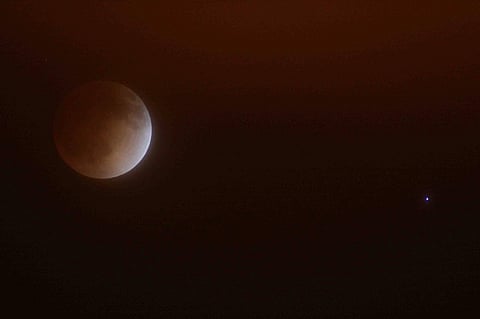Eid Al Adha celestial treat: Spica star and Moon align in night sky
The waxing gibbous Moon and Spica create a celestial spectacle for Eid Al Adha

Riyadh: Riyadh: A dazzling celestial event will grace the skies over Saudi Arabia and other neighbouring countries on Friday evening, June 6, 2025 — the first day of Eid Al Adha.
The event features a close conjunction between the waxing gibbous Moon and Spica (Alpha Virginis), the brightest star in the Virgo constellation and the 15th brightest star in the night sky.
According to the Saudi Press Agency, this rare alignment will be clearly visible to the naked eye after nightfall, requiring no special equipment, provided viewers are in areas free from light pollution.
The Moon and Spica will appear extremely close in the sky, separated by less than one degree — about 21.21 arcminutes. The Space and Astronomy Club said the visual pairing will offer a stunning sight for stargazers and an excellent opportunity for astrophotographers to capture the alignment.
Observers across the region are encouraged to look southeast after sunset for the best view of this Eid night spectacle.
Spica: Virgo’s brightest star
Spica, or Alpha Virginis, is the brightest star in the Virgo constellation and lies approximately 250 light-years from Earth. According to Space.com, Spica is a binary star system composed of two stars orbiting so closely that they appear as a single point of light. Combined, they shine more than 12,100 times brighter than the Sun.
The name "Spica" comes from the Latin word for "ear of grain," a nod to Virgo’s mythological image as a maiden holding a sheaf of wheat. Historically, Spica has guided navigation and timekeeping—from ancient Egyptian agricultural calendars to 16th-century maritime voyages. Today, it continues to play a key role in astronomy as a calibration star and is featured on Brazil’s national flag, representing the state of Pará.
How to spot Spica
Spica is easy to find in the night sky, especially during spring in the Northern Hemisphere. To locate it, follow the arc of the Big Dipper’s handle to the bright star Arcturus, then continue the arc to reach Spica. It rises in the southeast and reaches its highest point late at night. Its brilliant blue-white sparkle is unmistakable on a clear evening.
Sign up for the Daily Briefing
Get the latest news and updates straight to your inbox
![An aerial view shows Kingdom Tower in the Saudi capital Riyadh. [Illustrative image]](http://media.assettype.com/gulfnews%2Fimport%2F2020%2F05%2F26%2FSaudi-Riyadh_172500ec388_large.jpg?w=320&auto=format%2Ccompress&fit=max)


